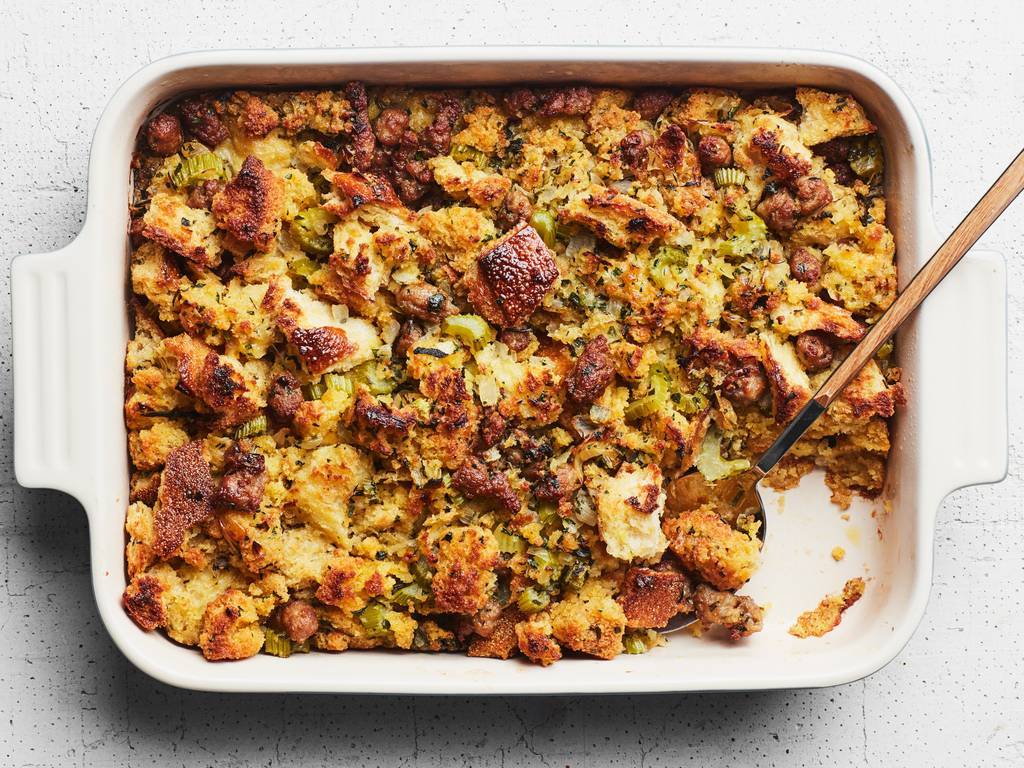Introduction
Is Stuffing Good For Weight Loss: Weight loss might initially seem counterintuitive, as this traditional holiday side dish is known for its savory richness and calorie-dense ingredients. However, the relationship between stuffing and weight loss is not as black and white as it may seem. While stuffing is not typically associated with weight loss, it’s essential to explore the nuances of how this beloved dish can fit into a weight management plan. A thoughtful and balanced approach to consuming stuffing, or any indulgent food for that matter, can harmonize with a weight loss. We’ll delve into the factors that influence the compatibility of stuffing with weight loss goals. We’ll explore ingredient choices, portion control, and strategies to make stuffing a more waistline-friendly addition to your meals. By the nutritional aspects and making mindful decisions, it’s possible to savor the flavors of stuffing while working toward your weight loss objectives.
The ingredients you choose for your stuffing can greatly impact its nutritional profile. To make stuffing more compatible with weight loss, opt for whole-grain bread or grains, which provide more fiber and nutrients than refined grains. Reducing or substituting butter with healthier fats like olive oil can also cut down on unnecessary calories. Incorporating a variety of vegetables can add flavor and bulk to the dish without adding excessive calories. One of the most critical aspects of including stuffing in a weight loss plan is portion control. While it’s a delicious accompaniment, stuffing can be calorie-dense. Be mindful of the serving size and try not to overindulge. Smaller portions can help you enjoy the flavors without sabotaging your calorie goals.
If you’re looking to lose weight, it’s important to consider your overall meal. Include stuffing as part of a well-balanced meal that includes lean proteins, plenty of vegetables, and other nutrient-rich sides. This can help you stay satisfied and manage your calorie intake effectively. It’s beneficial to be aware of the calorie content of stuffing and other dishes in your meal. Understanding the energy content of your foods can help you make informed choices and balance your daily calorie intake with your weight loss goals. Complementing your weight loss efforts with regular exercise is essential. Physical activity can help you burn extra calories and improve overall health. While weight loss may involve some dietary restrictions, it’s also important to enjoy your meals and find a balance between your goals and culinary pleasures. Special occasions like holidays can allow for indulgence, but moderation is key. If you’re on a specific weight loss program or have dietary restrictions due to health concerns, consider consulting a registered dietitian or healthcare professional for personalized guidance and meal planning.

Is stuffing high in fiber?
While traditionally prepared stuffing won’t have more than a gram or two of fiber, it is a side that can easily be infused with the good stuff.
Traditional stuffing, typically made with white bread, may not be particularly high in fiber. White bread is made from refined grains, and during the refining process, the bran and germ, which contain most of the fiber, are removed. As a result, stuffing made with white bread tends to be lower in fiber content.
However, if you make stuffing using whole-grain bread or whole wheat bread, you can significantly increase the fiber content. Whole grains, such as whole wheat, whole rye, or whole oats, contain the bran and germ, making them a good source of dietary fiber.
Incorporating additional ingredients like vegetables (such as celery, onions, carrots) and fruits (such as apples or dried cranberries) into your stuffing can also contribute to a higher fiber content. Vegetables and fruits are naturally rich in dietary fiber.
So, if you’re looking to boost the fiber content in your stuffing, consider using whole-grain bread and including a variety of fiber-rich ingredients. Homemade stuffing allows you to have more control over the ingredients, making it easier to create a higher-fiber version of this traditional dish.
Is stuffing a healthy food?
Stuffing is essentially bread, salt, and butter, so it probably comes as no surprise that it isn’t the healthiest food served on Thanksgiving. But you can cut its sodium and saturated fat, and pump up its nutritional profile.
Whether stuffing is considered a healthy food depends on various factors, including the ingredients used and how it is prepared. Traditional stuffing, often made for holiday meals, can be high in calories and may not always be considered a health-conscious choice due to its ingredients and preparation method. However, with some modifications, it can be made healthier.
Here are some factors to consider:
Ingredients: Traditional stuffing often includes bread, butter, and various seasonings. These ingredients can be high in calories, saturated fat, and sodium. To make stuffing healthier, you can use whole-grain bread, reduce the amount of butter or use a healthier fat source, and add more vegetables and herbs for flavor.
Vegetables: Adding a variety of vegetables like celery, onions, carrots, and mushrooms can increase the nutritional value of stuffing. These vegetables can provide fiber, vitamins, and minerals.
Portion Size: Moderation is key when consuming stuffing. It’s easy to overindulge, given its deliciousness, so be mindful of portion sizes to control calorie intake.
Sodium: Many traditional stuffing recipes use canned broths and bouillon cubes, which can be high in sodium. Opt for low-sodium or homemade broths to reduce the salt content.
Homemade vs. Store-Bought: Homemade stuffing allows you to control the ingredients and make healthier choices. Store-bought, pre-packaged stuffing mixes may contain added preservatives and artificial ingredients.
Cooking Method: Baking stuffing inside a turkey can lead to a higher calorie and fat content due to the absorption of turkey juices. Consider baking it separately to control the ingredients and portions.
Customization: You have the freedom to customize stuffing with healthier ingredients like whole grains, nuts, dried fruits, and lean proteins (e.g., turkey sausage). These additions can enhance both the flavor and nutrition of stuffing.
In summary, whether stuffing is a healthy food depends on how it’s prepared and the specific ingredients used. Making conscious choices like opting for whole-grain bread, adding more vegetables, and reducing the use of butter or high-sodium ingredients can make stuffing a healthier side dish. However, it’s essential to be mindful of portion sizes and not overindulge, especially during holiday meals.
Is stuffing good carbs?
Stuffing is usually based around white bread or corn bread, both of which are high in carbs and low in fiber, and the dish quickly becomes a sodium bomb thanks to all the stock used to make it. If you’re using a packaged mix, then you can add MSG and high-fructose syrup to the list of stuffing’s cons as well.
Whole Grains: You can use whole-grain bread or whole-grain cornbread to increase the fiber content of your stuffing. Whole grains are digested more slowly, providing a steadier release of energy.
Incorporate Vegetables: Add vegetables like celery, onions, carrots, or mushrooms to your stuffing mixture to increase its nutritional value and fiber content.
Homemade Stock: Make your own stock with reduced sodium to control the salt content in your stuffing.
Portion Control: Be mindful of portion sizes. While stuffing can be delicious, consuming it in moderation as part of a balanced meal is a good practice.
Experiment: Consider alternative stuffing recipes that use healthier ingredients, such as quinoa, brown rice, or whole-grain couscous as a base.
Limit Processed Mixes: If you prefer using pre-packaged stuffing mixes, read the labels carefully to choose options with fewer additives and lower sodium content.
Is stuffing high in fat?
It probably comes as no surprise that stuffing isn’t the healthiest addition to your Christmas or Thanksgiving plate, but that’s no reason to omit it. Typically high in fat, carbs and salt, stuffing can be made fresh or purchased chilled, frozen or dehydrated.
Butter or Oil: Many stuffing recipes call for the addition of butter or oil, which contributes to the overall fat content. These fats are often used to sauté vegetables or coat the bread or other grains.
Meat Ingredients: If you include meat, such as sausage or bacon, in your stuffing, this will significantly increase the fat content.
Nuts: Some stuffing recipes incorporate nuts like pecans or walnuts, which are high in healthy fats but can still contribute to the overall fat content.
Cheese: Some variations of stuffing include cheese, which adds both fat and flavor.
Cream-Based Sauces: Certain stuffing recipes involve cream-based sauces or gravies, which are high in fat.
Use less butter or oil: You can reduce the amount of butter or oil in your recipe or use healthier fats like olive oil or unsalted butter.
Choose leaner meat or plant-based options: If you want to include meat, opt for leaner choices or consider plant-based alternatives to reduce the overall fat content.
Go for whole grains: Using whole-grain bread or grains as the base for your stuffing can help reduce the fat content and increase the fiber and nutritional value.
Add more vegetables and herbs: Incorporate a variety of vegetables, herbs, and spices for flavor without relying as heavily on added fats.
Is stuffing high calories?
Bread stuffing contains 354 calories per 200 g serving. This serving contains 17 g of fat, 6.3 g of protein and 43 g of carbohydrate. The latter is 4.7 g of sugar and 1.8 g of dietary fiber, the rest is complex carbohydrate. Bread stuffing contains 3.3 g of saturated fat and 0 mg of cholesterol per serving.
Portion Size: The calorie content provided earlier is for a 200-gram serving. It’s important to keep in mind that the portion size you serve can significantly impact your overall calorie intake. Smaller portions will naturally have fewer calories.
Variations: Different types of stuffing can have varying calorie counts. For example, cornbread stuffing, wild rice stuffing, or sausage stuffing may have different calorie profiles due to their ingredients.
Healthier Ingredients: If you want to make stuffing with a lower calorie content, consider using whole-grain bread or grains, which are often lower in calories and higher in fiber. Reducing the amount of added fats, such as butter, can also reduce the calorie content.
Balanced Meal: When planning your holiday or special occasion meal, consider the overall balance. While stuffing can be calorie-dense, it’s typically served alongside other dishes like roasted meats, vegetables, and salads. The combination of these dishes can create a balanced meal.
Dietary Preferences: If you have specific dietary preferences or requirements, such as vegetarian or vegan, there are alternative stuffing recipes that use plant-based ingredients and can be lower in calories.
What is stuffing made of vegetarian?
Heat a frying pan until medium hot, add the butter, onions and sage and fry gently for five minutes until softened. Place the breadcrumbs in a bowl with the softened onions and mix to combine. Add the egg and season with salt and black pepper. Mix well then form into golf-ball sized balls and place on a roasting tray.
Vegetarian stuffing, also known as stuffing or dressing, is made without using meat or animal-based products. It’s a popular side dish, especially during holiday meals and celebrations. Vegetarian stuffing typically consists of a combination of bread, vegetables, herbs, and flavorful seasonings. Here’s a basic recipe for vegetarian stuffing:
Ingredients:
Bread: Start with a base of bread cubes. You can use whole-grain bread, French bread, sourdough, or any other type you prefer. Cut the bread into small cubes and let them dry out for a day or lightly toast them to help the stuffing hold together better.
Vegetables: You can include a variety of vegetables such as celery, onions, carrots, and mushrooms. Dice or chop them finely to blend well with the bread.
Seasonings: Flavor the stuffing with a blend of herbs and seasonings like sage, thyme, rosemary, parsley, salt, and black pepper. Fresh herbs are often preferred for their vibrant flavor.
Liquid: To bind the ingredients together and add moisture, use vegetable broth or vegetable stock. You can also add a bit of melted butter or olive oil for richness.
Optional Additions: Depending on your preferences, you can add various ingredients like nuts (e.g., pecans, walnuts), dried fruits (e.g., cranberries, apricots), or other ingredients for extra texture and flavor.
Is stuffing good for protein?
The favorite choice for the term “Stuffing” is 1 cup of moist type Bread Stuffing which has about 6 grams of protein. The amount of protein for a variety of types and serving sizes of Stuffing is shown below.
Protein Content: As mentioned earlier, the protein content in stuffing can vary depending on the recipe. It typically provides a moderate amount of protein, but it’s not a primary source. A 1-cup serving of moist bread stuffing may contain around 6 grams of protein, but this can vary based on the specific ingredients used.
Complementary Dish: Stuffing is commonly served as a side dish, often accompanying roasted poultry like turkey or chicken. The primary protein source in such a meal is typically the meat itself, with the stuffing providing added flavor and texture.
Protein Sources in Stuffing: The sources of protein in stuffing can include meat (if used), eggs, nuts, and the small amount of protein naturally present in the bread or grains used. If you’re looking to increase the protein content of your stuffing, consider using more protein-rich ingredients or incorporating lean meats or plant-based protein sources.
Dietary Preferences: If you follow a vegetarian or vegan diet, there are plant-based stuffing recipes that use ingredients like tofu, legumes, or plant-based sausages to increase the protein content while keeping the dish meat-free.
Balanced Meals: When planning holiday or special occasion meals, it’s important to ensure a balanced nutritional profile. While stuffing can add flavor and variety to the meal, consider including other dishes rich in protein, vegetables, and a variety of nutrients to create a well-rounded and satisfying feast.
Is stuffing good for cholesterol?
The traditional turkey-day feast, replete with fatty, high-cholesterol, high-fat, and starchy foods like drumsticks, mashed potatoes, gravy and stuffing, is generally anything but heart-healthy.
Whole Milk: Whole milk is the standard dairy milk option at Starbucks. It has the highest fat content among their milk choices, providing a creamier texture and flavor. It is higher in calories compared to other milk options.
2% Milk: This is reduced-fat milk, which contains less fat than whole milk while still providing a creamy texture. It’s a middle-ground option in terms of both flavor and calorie content.
Nonfat Milk (Skim Milk): Nonfat milk, also known as skim milk, has had almost all of its fat removed. It’s a low-calorie and low-fat choice for those looking to reduce their fat and calorie intake.
Half-and-Half (or Breve): Half-and-half is a combination of equal parts milk and cream, resulting in a richer and creamier texture compared to regular milk. It is higher in calories and fat than other milk options.
Heavy Cream: Heavy cream is the highest in fat and calories among the milk and cream options at Starbucks. It’s used for making rich, indulgent drinks.
Vanilla Sweet Cream: Starbucks also offers vanilla sweet cream, which is a sweetened cream with a vanilla flavor. It’s often used in iced coffee drinks, such as the Sweet Cream Cold Brew.

Conclusion
Stuffing, as traditionally prepared, may not be a direct ally in your weight loss due to its calorie-dense and often high-fat content. However, with thoughtful adjustments and mindful choices, it’s possible to enjoy stuffing without sabotaging your weight loss goals. To make stuffing more weight-loss-friendly, focus on ingredient selection, portion control, and balance. Opt for whole-grain bread or grains, reduce or substitute fats like butter with healthier options, and incorporate a variety of vegetables. Keep portion sizes in check and view stuffing as a complementary element in a well-balanced meal, alongside lean proteins and plenty of vegetables.
Maintaining calorie awareness and practicing moderation, especially during special occasions, is key. While the road to weight loss involves making choices that support your goals, it’s also about finding a balance between a healthy lifestyle and enjoying the flavors and traditions that make holidays special. Successful weight loss is a gradual process that combines mindful eating, regular physical activity, and overall lifestyle adjustments. By incorporating stuffing thoughtfully and in moderation, you can still savor the flavors of the season while making progress toward your weight loss objectives.
To create a more weight loss-friendly stuffing, consider incorporating healthy ingredients. Whole grains, lean proteins, and an abundance of vegetables can enhance the dish’s nutritional value without compromising on flavor. Develop the habit of mindful eating. Savor each bite, chew slowly, and listen to your body’s signals of hunger and fullness. This approach can prevent overeating and help you enjoy the flavors without excess calorie consumption. Prior to holiday gatherings, plan your meals and portion sizes. Setting a meal plan can help you stay on track and make thoughtful choices about which dishes, including stuffing, you’ll enjoy. Combining healthy eating with regular physical activity is crucial for successful weight loss. Engage in physical activities that you enjoy to help burn calories and enhance your overall health. Seek support from family and friends who are aware of your weight loss goals. A supportive environment can help you stay accountable and motivated during special occasions. If you’re tracking your nutrition, consider using apps or journals to log your food intake. This practice helps you stay accountable and understand the impact of your choices on your daily calorie goals.

